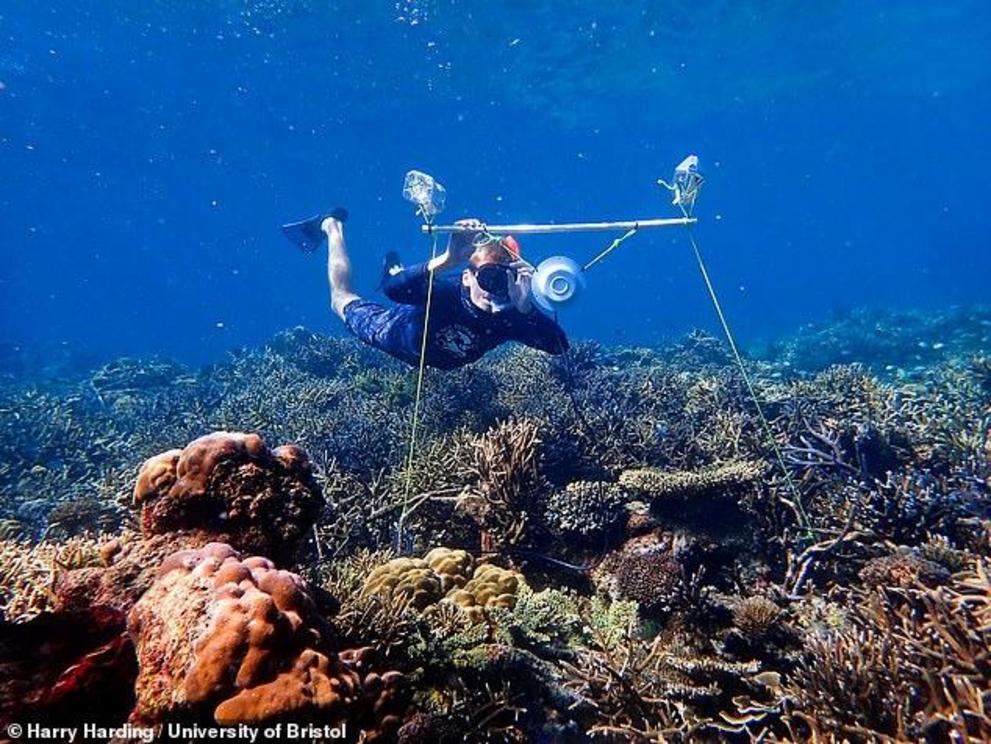Siren song: Great Barrier Reef 'could be revived' by playing sounds of healthy coral reefs via underwater loudspeakers to lure young fish back to damaged areas
- Healthy coral reefs are rich in ambient sounds that serve to attract young fish
- Fish help reefs to recover by cleaning and making room for new coral to grow
- Researchers deployed underwater loudspeakers on the Great Barrier Reef
- They found their sounds attracted twice as many fish to dead patches of coral
Dead patches on Australia's Great Barrier Reef could be revived by playing the ambient sounds of a healthy reef via loudspeakers to lure in young fish.
These fish help to clean the reef and make room in which new corals can grow, beginning the process of ecosystem recovery.
Increasingly frequent marine heatwaves have been creating dead patches in the barrier reef by 'bleaching', in which corals are forced to expel their symbiotic algae.
Dead patches on Australia's Great Barrier Reef could be revived by playing the ambient sounds of a healthy reef via loudspeakers to lure in young fish. Pictured, marine biologist Tim Gordon of the University of Exeter deploys an underwater loudspeaker onto the Great Barrier Reef
Marine biologist Tim Gordon of the University of Exeter and colleagues set up submarine loudspeakers in patches of dead coral around Lizard Island on Australia's recently devastated Great Barrier Reef.
These speakers played recordings of the sounds of a healthy reef — including the noises made my shoals of fish, shrimps, and other reef dwellers.
The researchers found that twice as many fish arrived at — and stayed near — the dead patches where the loudspeakers were operating than those where no sound was playing.
'Fish are crucial for coral reefs to function as healthy ecosystems,' said Mr Gordon.
'Boosting fish populations in this way could help to kick-start natural recovery processes, counteracting the damage we're seeing on many coral reefs around the world.'
The new technique works by reproducing the sounds that are lost when reefs are quietened by degradation, the researchers explained.
'Healthy coral reefs are remarkably noisy places — the crackle of snapping shrimp and the whoops and grunts of fish combine to form a dazzling biological soundscape,' said paper author and fellow Exeter marine biologist Steve Simpson.
'Juvenile fish home in on these sounds when they're looking for a place to settle.'
'Reefs become ghostly quiet when they are degraded — as the shrimps and fish disappear — but by using loudspeakers to restore this lost soundscape, we can attract young fish back again.'
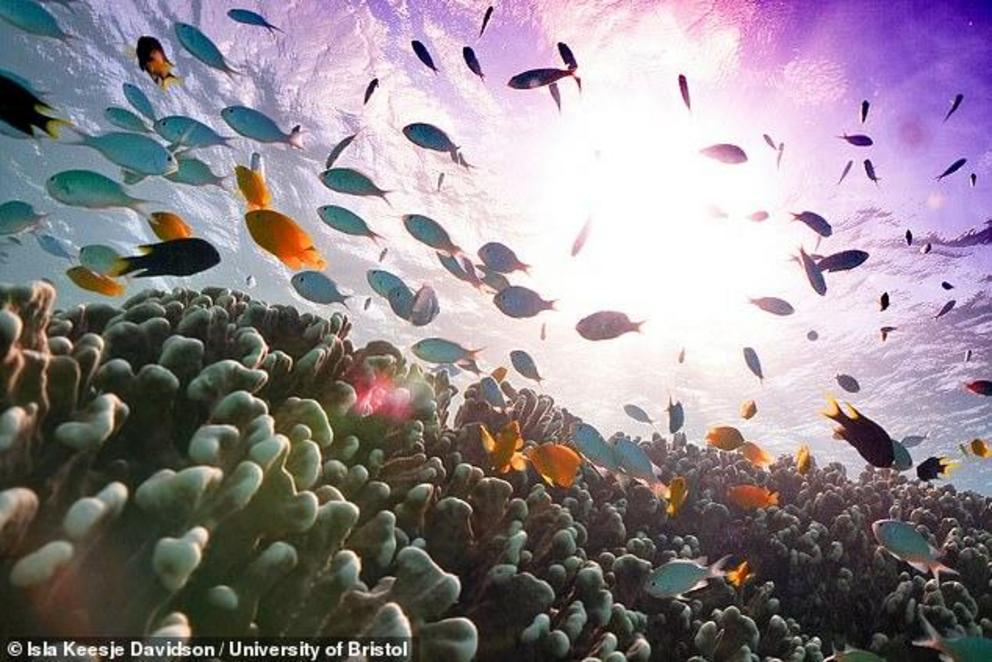 Fish help to clean the reef and make room in which new corals can grow, beginning the process of ecosystem recovery. Pictured, blue-green damselfish on the Great Barrier Reef
Fish help to clean the reef and make room in which new corals can grow, beginning the process of ecosystem recovery. Pictured, blue-green damselfish on the Great Barrier Reef
 Increasingly frequent marine heatwaves have been creating dead patches in the barrier reef, as pictured, by 'bleaching', in which corals are forced to expel their symbiotic algae
Increasingly frequent marine heatwaves have been creating dead patches in the barrier reef, as pictured, by 'bleaching', in which corals are forced to expel their symbiotic algae
 Tim Gordon of the University of Exeter and colleagues set up submarine loudspeakers in patches of dead coral on Australia's recently devastated Great Barrier Reef, as pictured
Tim Gordon of the University of Exeter and colleagues set up submarine loudspeakers in patches of dead coral on Australia's recently devastated Great Barrier Reef, as pictured
'Of course, attracting fish to a dead reef won't bring it back to life automatically, but recovery is underpinned by fish that clean the reef and create space for corals to regrow,' added biologist Mark Meekan of the Australian Institute of Marine Science.
The team found that broadcasting healthy reef sounds doubled the total number of fish arriving onto experimental patches of reef habitat and in doing so increased the number of species present by 50 per cent.
This increased diversity included species from all sections of the food web — including plant-eaters, plankton-eaters, fish-eating predators and creatures that feast on decomposing plant and animal matters.
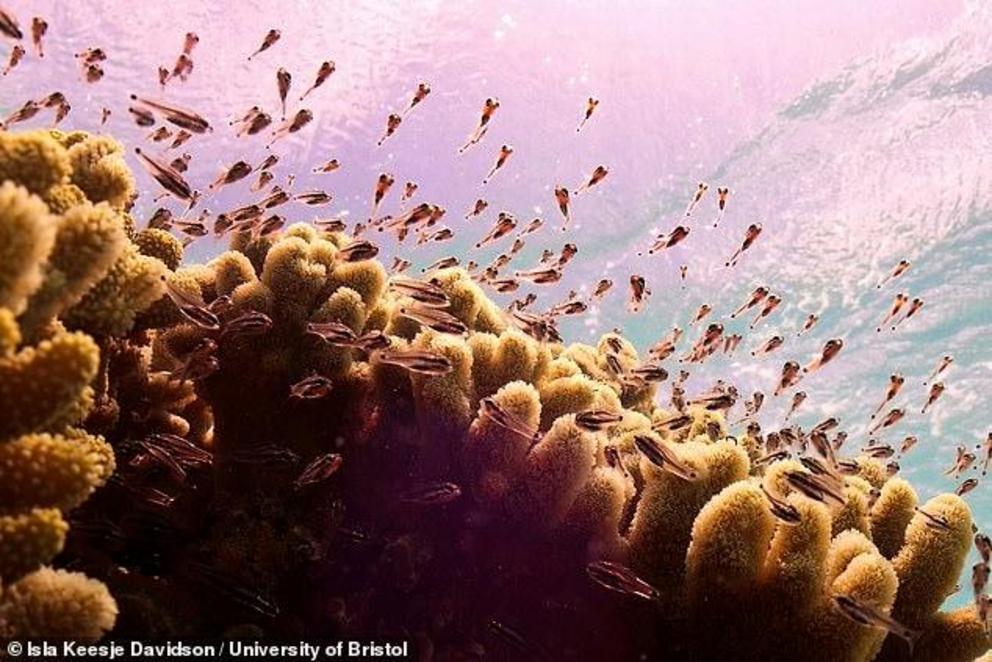 The underwater speakers played recordings of the sounds of a healthy reef — including the noises made my shoals of fish, shrimps, and other reef dwellers. Pictured, young cardinal fish swimming around healthy coral on the Great Barrier Reef
The underwater speakers played recordings of the sounds of a healthy reef — including the noises made my shoals of fish, shrimps, and other reef dwellers. Pictured, young cardinal fish swimming around healthy coral on the Great Barrier Reef
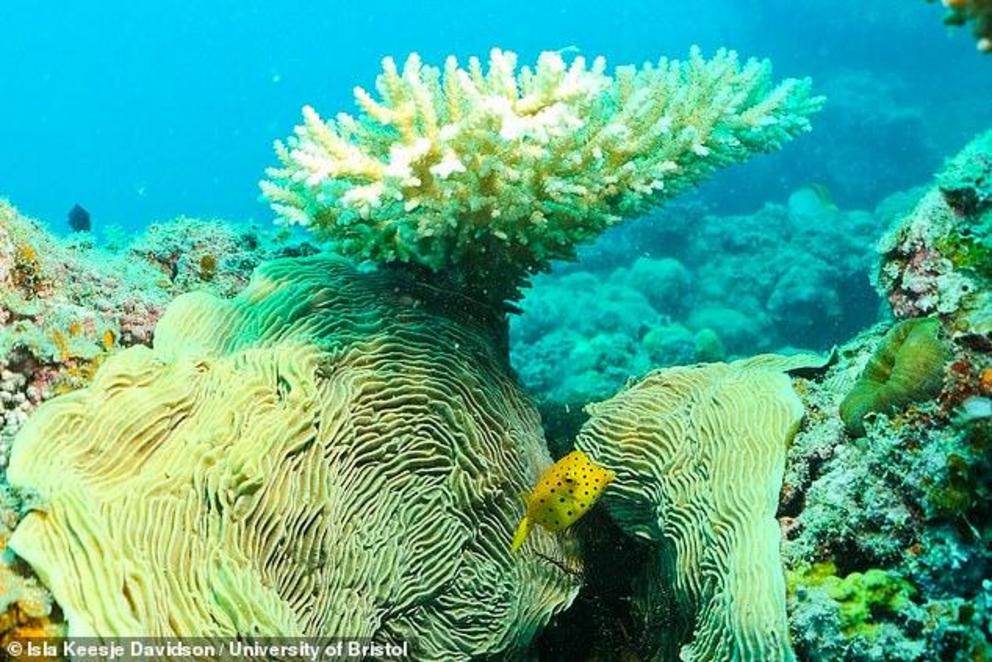 'Fish are crucial for coral reefs to function as healthy ecosystems,' said Mr Gordon. 'Boosting fish populations in this way could help to kick-start natural recovery processes, counteracting the damage we're seeing on many coral reefs around the world.'
'Fish are crucial for coral reefs to function as healthy ecosystems,' said Mr Gordon. 'Boosting fish populations in this way could help to kick-start natural recovery processes, counteracting the damage we're seeing on many coral reefs around the world.'
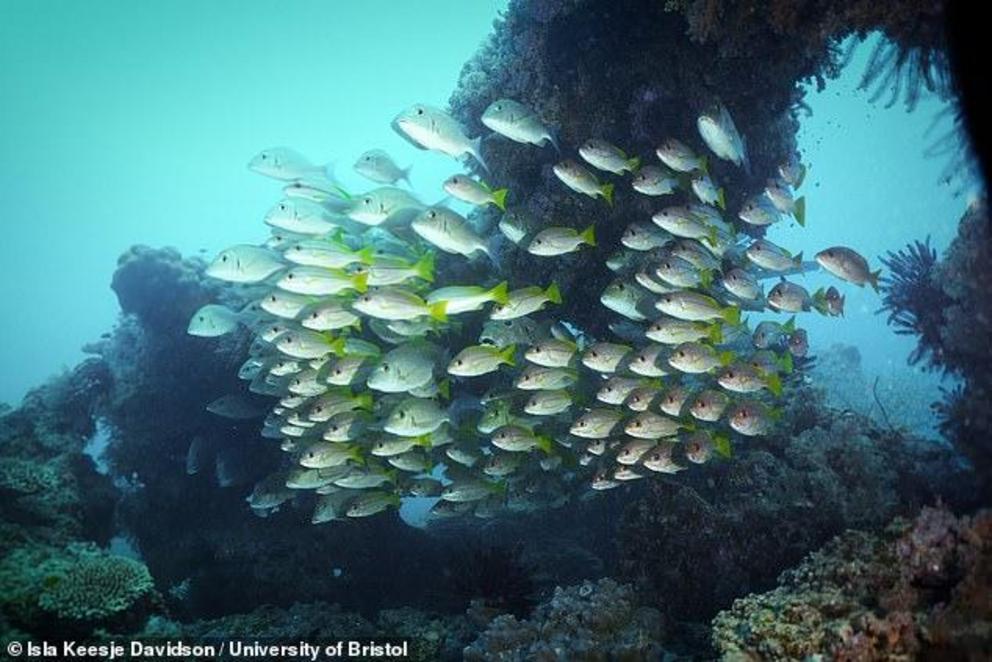 The acoustic technique works by reproducing the sounds that are lost when reefs are quietened by degradation, the researchers explained. Pictured, a school of snapper swims through a patch of coral on the Great Barrier Reef
The acoustic technique works by reproducing the sounds that are lost when reefs are quietened by degradation, the researchers explained. Pictured, a school of snapper swims through a patch of coral on the Great Barrier Reef
Different species of fish provide different functions on coral reefs, meaning that an abundant and diverse fish population is important for maintaining a healthy ecosystem.
'Acoustic enrichment is a promising technique for management on a local basis,' said .
'If combined with habitat restoration and other conservation measures, rebuilding fish communities in this manner might accelerate ecosystem recovery.'
'However, we still need to tackle a host of other threats including climate change, overfishing and water pollution in order to protect these fragile ecosystems.'
 'Healthy coral reefs are remarkably noisy places — the crackle of snapping shrimp and the whoops and grunts of fish combine to form a dazzling biological soundscape,' said paper author and fellow Exeter marine biologist Steve Simpson. Pictured, an underwa
'Healthy coral reefs are remarkably noisy places — the crackle of snapping shrimp and the whoops and grunts of fish combine to form a dazzling biological soundscape,' said paper author and fellow Exeter marine biologist Steve Simpson. Pictured, an underwa
 'Reefs become ghostly quiet when they are degraded — as the shrimps and fish disappear — but by using loudspeakers to restore this lost soundscape, we can attract young fish back again,' said paper author and fellow Exeter marine biologist Steve Simpson.
'Reefs become ghostly quiet when they are degraded — as the shrimps and fish disappear — but by using loudspeakers to restore this lost soundscape, we can attract young fish back again,' said paper author and fellow Exeter marine biologist Steve Simpson.
 'We still need to tackle a host of other threats including climate change, overfishing and water pollution in order to protect these fragile ecosystems,' warned Bristol University behavioural ecologist Andy Radford. Pictured, a coral rubblefield in Sulawe
'We still need to tackle a host of other threats including climate change, overfishing and water pollution in order to protect these fragile ecosystems,' warned Bristol University behavioural ecologist Andy Radford. Pictured, a coral rubblefield in Sulawe
'Whilst attracting more fish won't save coral reefs on its own, new techniques like this give us more tools in the fight to save these precious and vulnerable ecosystems,' added Mr Gordon.
'From local management innovations to international political action, we need meaningful progress at all levels to paint a better future for reefs worldwide.'
The full findings of the study were published in the journal Nature Communications.
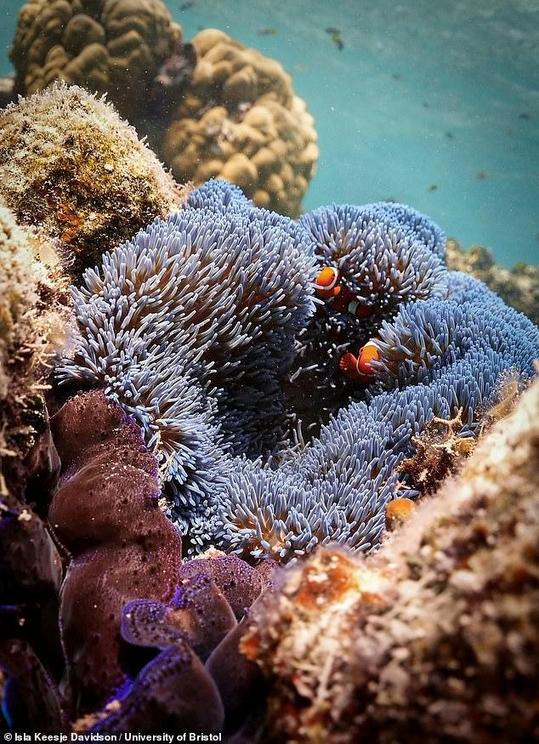 Different species of fish provide different functions on coral reefs, meaning that an abundant and diverse fish population is important for maintaining a healthy ecosystem. Pictured, clownfish shelter amidst the tentacles of an anemone on the Great Barrie
Different species of fish provide different functions on coral reefs, meaning that an abundant and diverse fish population is important for maintaining a healthy ecosystem. Pictured, clownfish shelter amidst the tentacles of an anemone on the Great Barrie
 The team found that broadcasting healthy reef sounds doubled the total number of fish arriving onto experimental patches of reef habitat and in doing so increased the number of species present by 50 per cent. Pictured, a coral shelters lemon damselfish
The team found that broadcasting healthy reef sounds doubled the total number of fish arriving onto experimental patches of reef habitat and in doing so increased the number of species present by 50 per cent. Pictured, a coral shelters lemon damselfish
 'Whilst attracting more fish won't save coral reefs on its own, new techniques like this give us more tools in the fight to save these precious and vulnerable ecosystems,' added Mr Gordon
'Whilst attracting more fish won't save coral reefs on its own, new techniques like this give us more tools in the fight to save these precious and vulnerable ecosystems,' added Mr Gordon
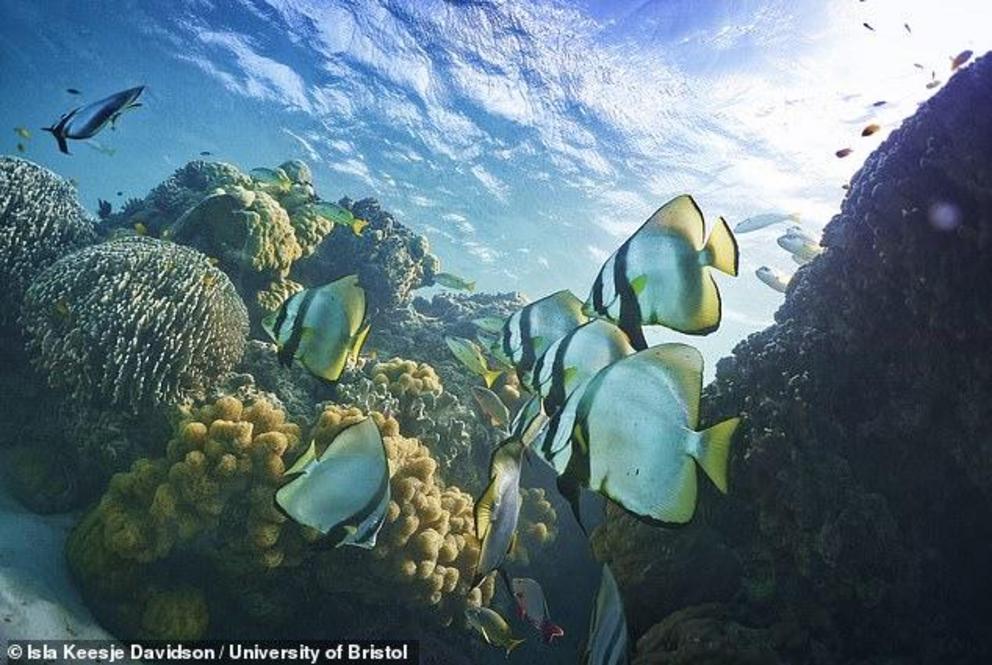 'From local management innovations to international political action, we need meaningful progress at all levels to paint a better future for reefs worldwide,' Mr Gordon said
'From local management innovations to international political action, we need meaningful progress at all levels to paint a better future for reefs worldwide,' Mr Gordon said
 Marine biologist Tim Gordon of the University of Exeter and colleagues set up submarine loudspeakers in patches of dead coral around Lizard Island on Australia's recently devastated Great Barrier Reef
Marine biologist Tim Gordon of the University of Exeter and colleagues set up submarine loudspeakers in patches of dead coral around Lizard Island on Australia's recently devastated Great Barrier Reef
WHAT IS CORAL BLEACHING?
Corals have a symbiotic relationship with a tiny marine algae called 'zooxanthellae' that live inside and nourish them.
When sea surface temperatures rise, corals expel the colourful algae. The loss of the algae causes them to bleach and turn white.
This bleached states can last for up to six weeks, and while corals can recover if the temperature drops and the algae return, severely bleached corals die, and become covered by algae.
In either case, this makes it hard to distinguish between healthy corals and dead corals from satellite images.
This bleaching recently killed up to 80 per cent of corals in some areas of the Great Barrier Reef.
Bleaching events of this nature are happening worldwide four times more frequently than they used to.
 An aerial view of Australia's Great Barrier Reef. The corals of the Great Barrier Reef have undergone two successive bleaching events, in 2016 and earlier this year, raising experts' concerns about the capacity for reefs to survive under global-warming
An aerial view of Australia's Great Barrier Reef. The corals of the Great Barrier Reef have undergone two successive bleaching events, in 2016 and earlier this year, raising experts' concerns about the capacity for reefs to survive under global-warming
Video can be accessed at source link below.

